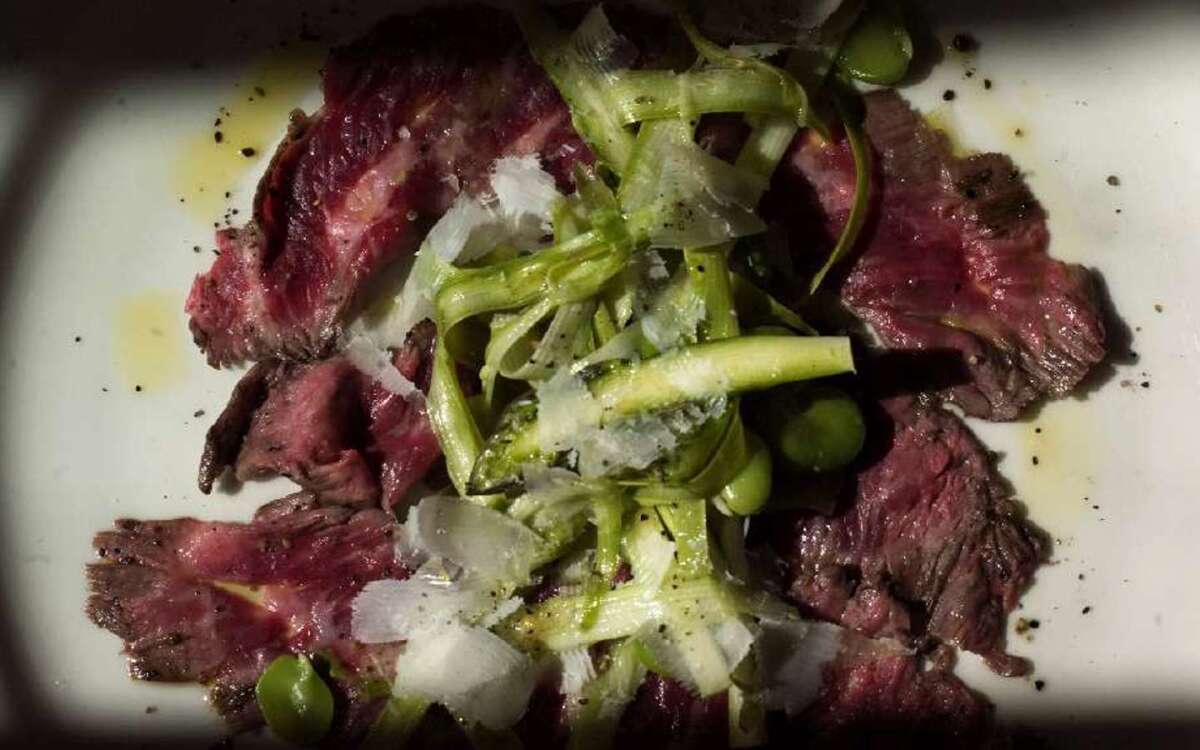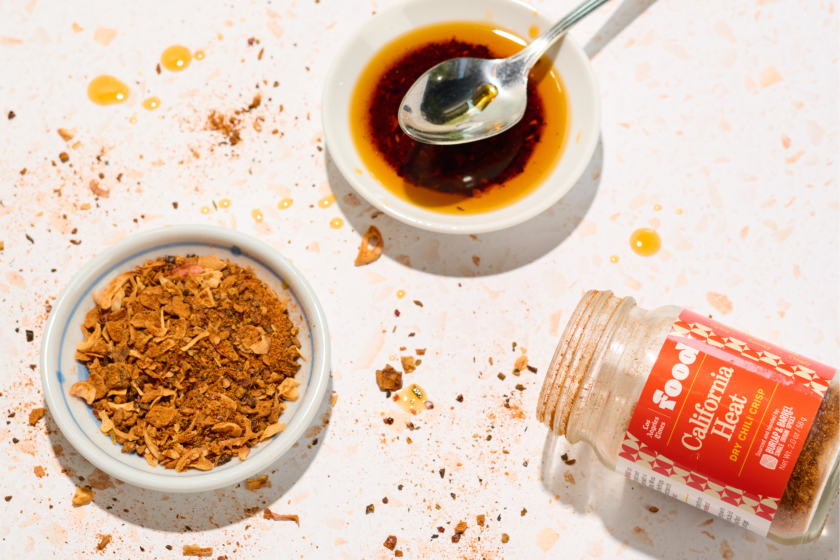Skirt steak carpaccio with raw asparagus and fava salad

On a recent afternoon in the sun-filled kitchen at the back of Gjelina restaurant in Venice, chef Travis Lett mans an oven in which he’s baking several loaves of golden-crusted bread. “I’m looking for good color, nice ‘ears,’ ” Lett says, referring to the edge on top of the bread where it has split.
He’s dialing in the final details for his latest project, Gjelina Take Away (or GTA), a next-door annex that has Lett baking breads, jarring pickles and curing meats for what he envisions as a neighborhood deli selling “everyday stuff” -- pizza, antipasti, sandwiches -- set to open this month. “I want to get away from food that’s too precious,” he says. “Straight up, elemental, not fussy at all. I’m trying to get better at that.”
What’s to get better at? For the last three years, Lett, who is 32, has helped steer the success that is Gjelina: a constant swirl of diners who spill onto the Abbot Kinney Boulevard sidewalk waiting for a turn to eat in the open-all-day, brick-floored, Edison-bulb-accented restaurant. They come for his thin-crusted pizzas from the wood-burning oven, straight-from-the-farm vegetables such as roasted okra or grilled kale, and plates of rustic chickpea stew or stuffed eggplant or pork meatballs -- food that’s seemingly simple but made exactingly.
As Lett puts it: “We’re working really hard to not look like we’re working really hard.” That might be Lett’s approach to life, which lends him an air of likable nonchalance. On the surface, it seems as if everything comes to him easily.
Next year he’ll try to translate some of the minimalism and grace that works so well in bohemian-bourgeois Venice to a neighborhood better known for fancy and flash. Lett, who says he will continue to be a part of Gjelina, and a new partner have signed a lease for a restaurant on Hollywood Boulevard in the space that was formerly Kung Pao Kitty. It’s 2,500 square feet of restaurant on top of 2,500 square feet of basement, enough room for a locker to smoke and cure meats and maybe equipment to brew his own beer.
“Concept?” he asks. “That word scares me. Do I have to have a concept?”
Direct approach
At the heart of Gjelina is a kitchen staff that has grown from about 10 to nearly 50 people, cranking out a menu of several dozen dishes for which they make each component down to the creme fraiche and grainy mustard: ricotta, sauerkraut, knife-cut buckwheat pasta, guanciale, merguez sausage.... It takes three days to make the pizza, starting with the dough’s pre-ferment.
Produce from the Santa Monica farmers market now makes up 90% of the vegetables on the menu (and there are a lot of vegetables on the menu) -- two truckloads’ worth every Wednesday and Saturday, crates stacked to the roof in the alley behind the kitchen. “This is stuff that’s caked in dirt, has root bases, it goes from field to truck to restaurant,” Lett says. Washing and drying lettuce alone is practically a full-time job.
On any given Saturday, from morning to night, 1,000 people will have filled the 100-seat restaurant. “That’s 10 turns with a small margin for error,” Lett says. Even through the worst of the recession, each month has been busier than the last. And on a Monday at 10 p.m., you will still have to wait 45 minutes if you show up without a reservation.
Gjelina’s popularity has chafed some neighbors, who have prevented Lett from expanding to an aerie above the restaurant where he once planned a separate vegetarian kitchen and dining room, now used only for private events. Recently, a Venice civic organization has challenged city approval allowing Gjelina to increase the number of seats.
In some ways, Gjelina is an unlikely success story. The restaurant opened with no publicity, no sign, no valet. Lett, who says he’s “not even a highly trained chef, just a resourceful guy,” had literally bumped into the job after meeting the owner on the street. And despite his penchant for conversation and his model good looks, he has shied away from media and refused television appearances at a time when it’s the norm for self-promoting young chefs to jump at the chance to star on reality TV.
A different recipe
Lett grew up in tiny, affluent Chatham, N.J., a Manhattan bedroom community where his mom introduced him to farmers markets. “Forget that it was the ‘80s,” he says, “it was New Jersey. On weekends she got in the car and drove an hour and a half [to the market]. She worked, but when she got home and before she even put her bag down, I heard the stove click on. And we were expected to be at the table. Absolutely.” She cemented the idea that “food represented your relationship to the environment, your relationship to your health, there was that connection,” he says.
His cooking career path wasn’t conventional: “Culinary school, staging, working at Per Se, I don’t know anything about that,” he says. “The benefit is we’re all a product of experience, and mine was unorthodox, so I run a kitchen a little bit unorthodox. I don’t know whether that’s unfortunate or fortunate. I just embrace it.”
During college as an art student at the University of Colorado at Boulder, he cooked at an Italian restaurant for a few years. He left school, moved to L.A. on a whim and lived out of his car for a while. He was at the right place at the right time and landed a job as head chef at Japanese restaurant Tengu in Westwood.
By 24, he was the executive chef at the W in Westwood, running a hotel union kitchen and facing all the challenges that came with it, including at one point having to lay people off. “I quit. It honestly fried me,” he says. “I never wanted to cook again.” Still, he came away from the job with a more ingredient-driven, casually elegant approach. He credits Kelly Courtney, his predecessor at the W, for starting “to undo that precise plating. I’d be bent over with my squeeze bottle,” and she’d make fun of it.
He did cook privately for movie producer Joel Silver and then was asked to consult for Gjelina, “to help make some decisions in kitchen design,” Lett says. So he rolled with it: “ ‘Give me a dream kitchen, with a wood oven, Montague ranges,’ and they pulled the trigger on it, and I thought, ‘Wow, this is going to be a cool kitchen.’ I wasn’t convinced I was going to cook at all.... It just sort of happened.”
He set out to create a simple menu that wouldn’t require much of his involvement in case he burned out. “Just some pizzas and salads,” he says. “That was the most ignorant thought ever. I admit that our pizzas were average” at first. But even then Times restaurant critic S. Irene Virbila called them “a siren’s call to Westside pizza lovers” in her review. (The restaurant is selling 300 to 400 pizzas a day.) Now “I’m constantly analyzing it. Seeing my pizza come out right has become a personal thing.”
Propped on a counter in the new GTA space -- all white marble and skylight designed by Marshall Agriam Studio -- he describes himself as political about food, at least partly influenced by experiences at his grandparents’ farm in Ohio. “The farm once had chickens, cows, pigs. But then they grew corn because it was sink-or-swim. It was mysterious -- why there were no chickens in the chicken coop -- and it left a question no one seemed to answer. That really left a feeling.
“But I don’t have to talk about it at the coffee shop. The best way to be involved is to buy what’s local, what’s in season.... I’m actually surprised how long this took to become mainstream. At this point it should be standard.”
Then he notices the plastic container of biga -- the dough starter for his ciabatta -- that he has been carrying back and forth between Gjelina and GTA for the last several weeks, testing recipes and his new ovens.
“Now, I’ve got to bake more bread.”
In a pot of boiling water, blanch the fava beans until brightly colored but still almost raw, less than 1 minute. Shock in a bowl of ice water and set aside.
Lightly season the skirt steak with one-half teaspoon salt and a pinch of pepper, and lightly drizzle with 1 teaspoon olive oil. Heat a cast iron skillet over high heat until very hot, about 5 minutes. Place the steak in the hot pan to get a nice, dark sear on the surface, 30 seconds to 1 minute on each side. Be careful not to cook the steak; it should remain raw inside. Slice the steak across the grain into one-half-ounce pieces (about 16 slices).
Place a sheet of plastic wrap on a work surface and lightly oil. Place the sliced meat on top and cover with another sheet of plastic, leaving some space between slices so that there is room for each slice to spread when you pound it. Using a meat mallet or the back of a flat saute pan, gently pound the meat until it is thin (but not so thin it might tear when handled). Place a few slices on each of four plates.
Trim the tough ends off of the asparagus spears and slice off the very tips; discard the tough ends and save the tips. On a flat surface, shave the raw asparagus into thin lengthwise strips (it will look like strips of pasta) using a vegetable peeler. Place the shaved asparagus and tips into a medium bowl and add the fava beans. Drizzle over 2 teaspoons each lemon juice and olive oil, and season with one-fourth teaspoon salt and a pinch of pepper. Taste and adjust the lemon juice and seasonings as desired. The salad should be bright and fresh, without being too acidic or oily.
Lightly season the carpaccio with flaky sea salt and cracked pepper and top with the asparagus salad. Thinly shave the Parmigiano-Reggiano over the top and serve.
Get our Cooking newsletter.
Your roundup of inspiring recipes and kitchen tricks.
You may occasionally receive promotional content from the Los Angeles Times.
















